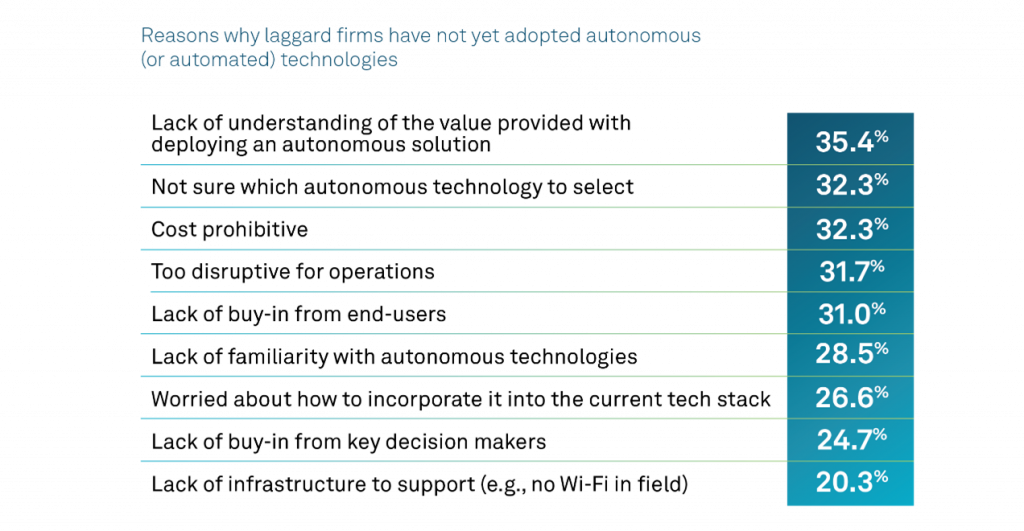The dawn of autonomous technology in construction is an exciting prospect, promising increased efficiency, safety, and cost savings. Yet, these advancements are often met with resistance and hesitation; in fact, a recent study on construction automation found that 31% of commercial construction firms who have resisted implementing technology do so because of a lack of buy-in from end users.
The transition from traditional methods to automated processes can be a complex journey marked by challenges and uncertainties. Therefore, it is critical to understand the hurdles that may hamper the adoption of these technologies and devise effective strategies to navigate them.
To successfully adopt autonomous technology, addressing the challenges and concerns that may hinder end-user buy-in is essential. Caity Taylor, Avvir’s Director of Solutions Engineering and a seasoned expert in construction project management and VDC, offers valuable insights on how technology leaders can overcome common obstacles in the adoption of autonomous technology.
Focus on education and training: Workers in the construction industry tend to prefer tried-and-true methods — and with the introduction of autonomous technology, some may view it as a threat to their job security. To overcome this, firms should educate workers on how these tools can improve their job performance while still requiring human oversight. Clear case studies demonstrating the return on investment (ROI) of adopting new technology can help workers understand its benefits.
In addition, firms can “game-ify” the process by celebrating teams that embrace the technology, providing on-site training and gathering feedback to make the transition smoother and highlight the benefits of the technology.
Create an overhead budget: Unless autonomous technology is specifically funded or directed by the owner, teams may hesitate to deploy new technologies if the costs must come from their own project budget. To overcome this barrier, firms can provide an “overhead” innovation budget to test new tools and increase end-user buy-in. This budget will not only help teams become more receptive to new technologies, but it will also allow them to see the value in autonomous technology and the return on investment it can provide.
In addition, having a dedicated budget for innovation and new technologies will give teams the financial support they need to experiment and adopt new solutions to improve safety and efficiency in construction projects.
Demand interoperability: Overcoming the interoperability challenge is crucial for successfully adopting autonomous technology in construction. The hurdles of transferring data between platforms can often obstruct the deployment of these systems. It’s important to push for collaboration among software providers and prioritise seamless data exchange to address this.
According to Taylor, customers hold significant sway in this regard, “As a customer, your opinion matters — and if software providers consistently hear the need for interoperation, they will respond.” By advocating for interoperability, the software solutions will become more integrated, facilitating a smoother adoption process for end-users.
Take a phased approach: Another challenge that end users face is being asked to solve everything all at once, which often results in no progress being made. To overcome this, firms should take a phased approach, starting with deploying AI and robots for simple, repetitive tasks while retaining human oversight for critical decision-making processes.
Start with your BIM: Finally, the BIM must become the driver when it comes to autonomous technology. The accuracy of autonomous technology installations is only as accurate as the BIM can prescribe. This means that the draftspeople creating these models must be as careful in their craft as those performing the installations. Firms should prioritise the creation of an accurate BIM as the foundation for all autonomous technology installations.
Construction firms can increase end-user adoption of autonomous technology and reap the benefits of enhanced safety, efficiency, and cost savings by overcoming common challenges through effective education, proper funding and strategic planning. Embracing these best practices will ensure the successful implementation of your autonomous technology initiative.
Learn more about how construction firms implement automation in our Autonomous Construction Tech Outlook, derived from a survey of over 1,000 industry leaders.


















